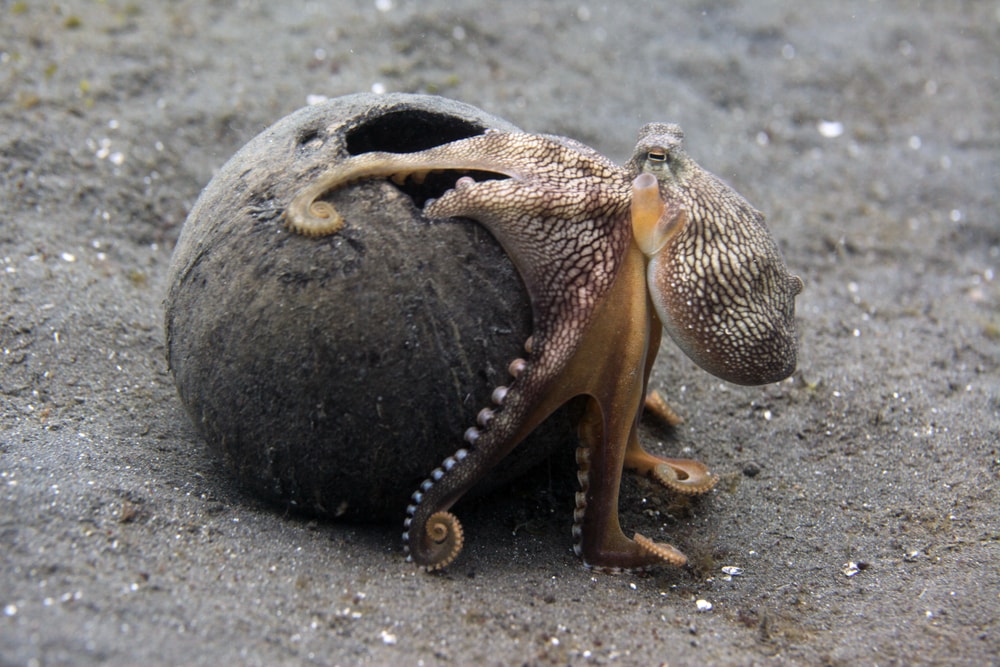Outforia Quicktake: Key Takeaways
- Coconut octopuses use coconut shells as protective homes and carry them for later use
- These intelligent creatures can problem-solve, escape from tiny holes, and even solve puzzles
- Coconut octopuses live on the ocean floor and have a diet consisting of crustaceans and mollusks
- They have a lifespan of three to five years and are listed as “least concern” by the IUCN
- Coconut octopuses can use water-powered jet propulsion to move, but usually crawl across the seafloor
Octopuses are highly intelligent creatures. Coconut octopuses might be the smartest of them all.
Recently, researchers saw coconut octopuses using coconut shells as protective homes. Not only that, but they carry them around for later use. It was the first time researchers had seen an invertebrate use a tool.
Besides being smart, coconut octopuses are beautiful animals with dark, veined bodies. Their stark white suckers contrast with their dark mantles. The colors make their arms look like they’re glowing.
These tiny animals live on the ocean floor, where the substrate is bare and there are few places to hide. It’s no wonder they’ve come up with a clever way to protect themselves.
What is an Octopus?
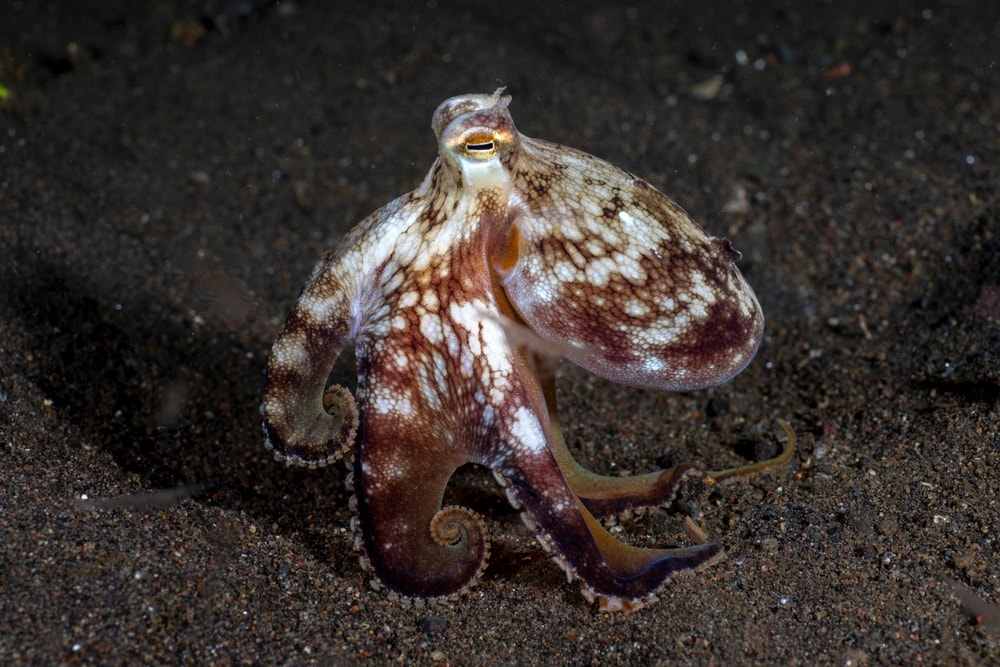
Octopuses are cephalopods, a type of animal that also includes cuttlefish and squids. They are invertebrates; they have no bones. Instead, they have soft and extremely flexible bodies.
Octopuses are fascinating creatures like no other. They have three hearts, two of which pump blood to the gills, while the other pumps blood through the rest of the body.
Larger animals frequently prey on small octopuses, but sometimes they can escape. Losing an arm to a hungry predator is not the end of the world; they can grow their arms back.
Most impressive of all, octopuses are some of the most intelligent animals on the planet. Their brains contain about 500 million large neurons. Compare that to a human’s brain, which has about 1 billion smaller neurons.
Octopuses can problem-solve, a characteristic not shared by many animals. They can escape from the tiniest holes, open jars, and even solve puzzles.
One octopus would escape its aquarium enclosure at night to steal fish from other tanks. The octopus stumped its keepers. That was until they realized the octopus was letting itself in and out of its tank each night.
How are Coconut Octopuses Different From Other Octopuses?
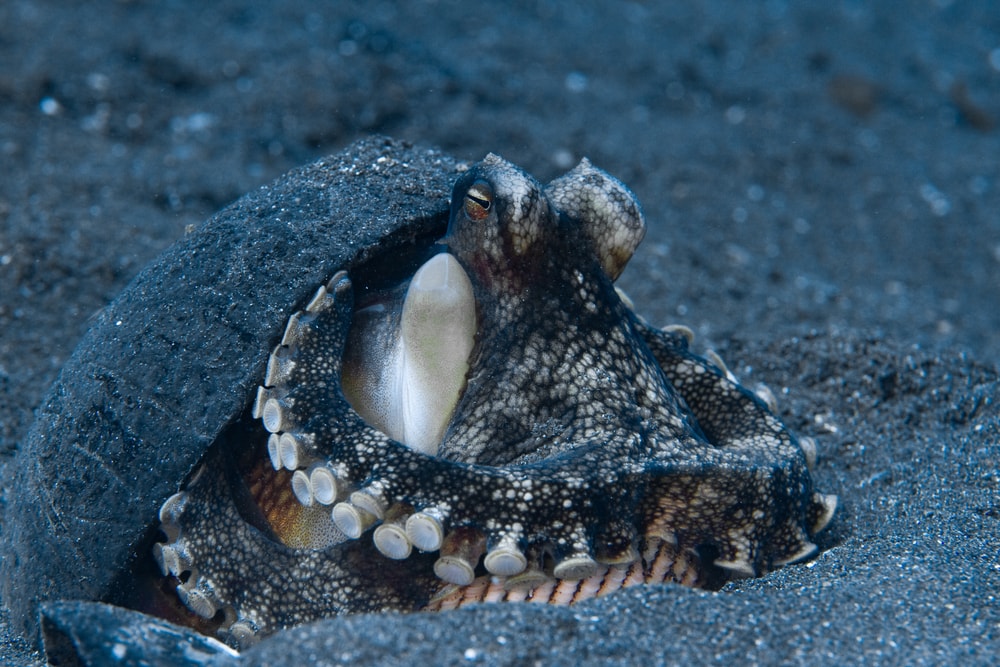
The coconut octopus (Amphioctopus marginatus) was scientifically categorized in 1964. It didn’t receive its common name, “coconut octopus,” until sometime later.
The name “Amphictoopus” roughly means “being able to change shape” and that the animal is “an octopus.” The name “marginatus” roughly means that the animal “lives in the sea” and is “very careful and cautious.”
Coconut octopuses differ from other octopuses because they use a tool for protection. Their tools of choice are coconut shells.
One study defines a “tool” as “a beneficial object that is not used right away; it is saved for later use.”
The coconut is very beneficial to these octopuses when they are in danger. It makes it difficult for prey to get to them.
It is unbeneficial when not in use. Octopuses must suction the coconut shell to themselves. This takes a lot of energy and makes walking awkward.
What Do Coconut Octopuses Look Like?
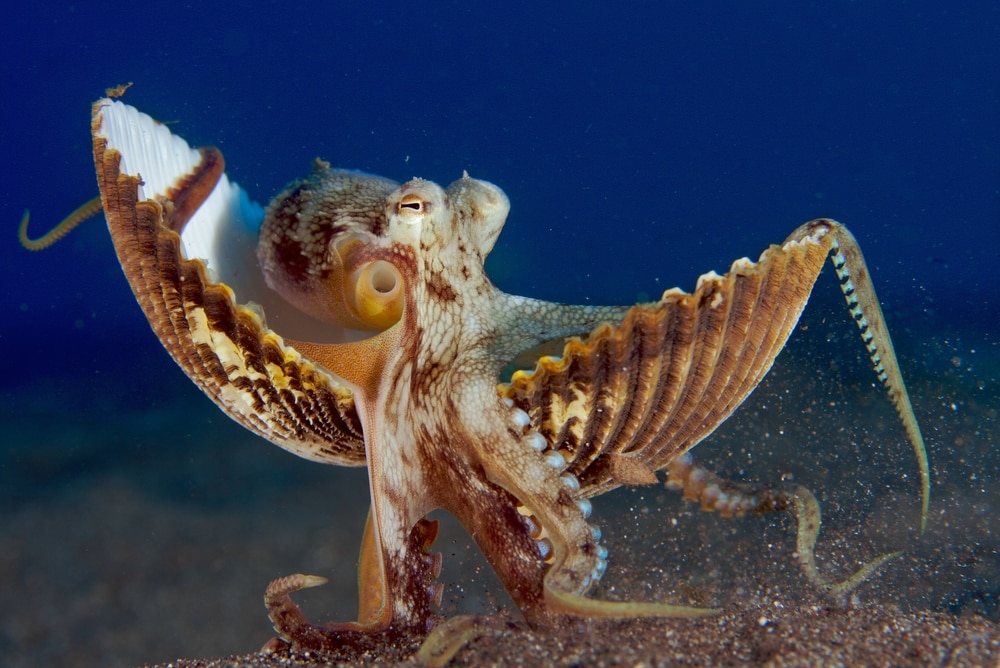
Coconut octopuses are also known as “veined octopuses.” They have dark, purplish-brown lines running across their bodies that look like veins. The rest of their body is a light to dark brown to help them blend in with their surroundings.
Their funnel is a brighter yellowish-tan color that doesn’t blend in as well. Two white spots sit at the top of their mantels, and a thin bar stretches across their heads.
Each of its eight arms has about 150 suckers, which are whitish-pink. They are highly noticeable against the dark skin of the rest of their bodies.
Though the mantle is a light to dark brown, each arm has a rim of dark purplish-brown. It noticeably contrasts with the sucker’s light color.
Coconut octopuses have four long, diamond-shaped ridges across their dorsal mantle. Each eye has one large papilla that can be used to feel things.
Like most octopuses, coconut octopuses have chromatophores — color-changing cells that help with camouflage.
They are small creatures. Their mantles only grow to about 6 in (15 cm) long; most only grow up to 4 in (10 cm) long. With their arms, their entire body can grow to about 12 in (30 cm) long. Their arms tend to be two to three times longer than their mantle.
These small octopuses only weigh about 400 g (14.1 oz).
Males vs Females
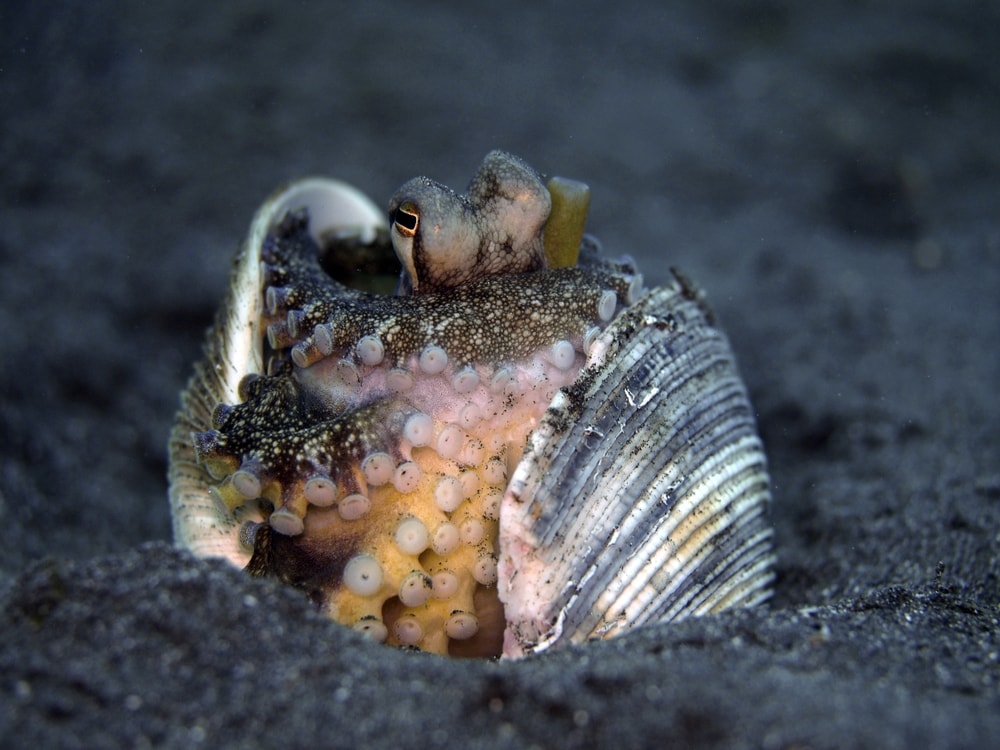
You can tell males from females by looking at the third arm on the right side of their body.
A male’s third arm is a hectocotylus, a specialized arm that they use for fertilization. A male’s specialized arm lacks suckers, while females have a regular third arm with suckers.
Coconut Octopus Range
These octopuses live in the tropical waters of the Indian and Western Pacific Oceans. Their range spans from South Africa to India. They live near Taiwan, the Philippines, Japan, and north-eastern Australia.
Coconut Octopus Habitat
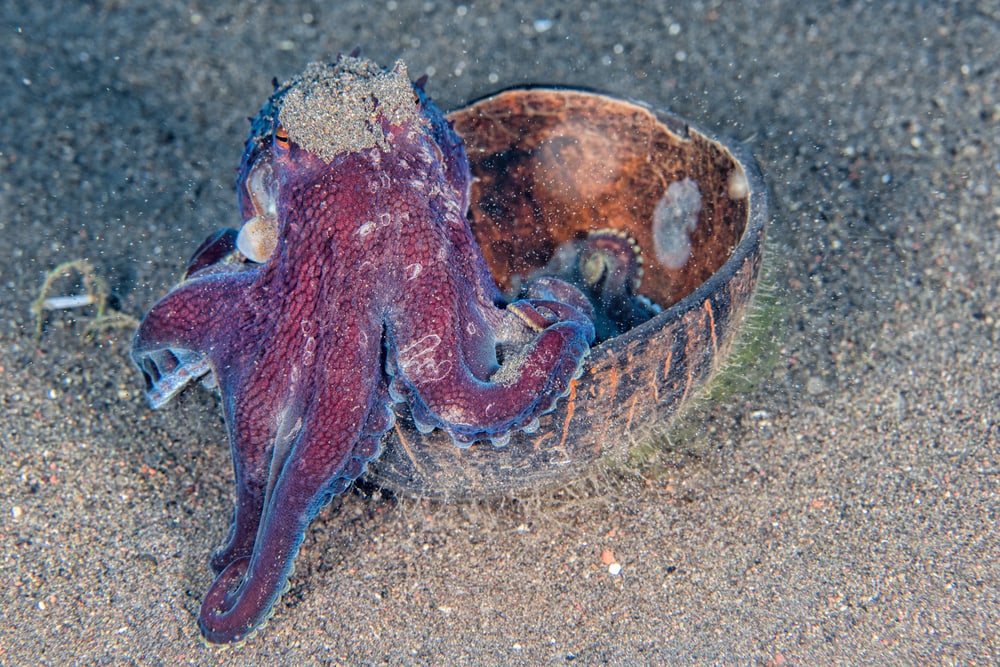
They spend most of their time on the ocean floor, crawling around the sandy or muddy substrate.
In the mud, coconut octopuses share their habitat with creatures like sea cucumbers. These funny creatures also bury themselves in the mud.
In the water, they share their habitat with many non-predators. Some of these animals include the lunartail puffer fish and the Portuguese man of war.
They tend to stay in shallower waters but sometimes live at depths up to 144 ft (44 m). Some of their favorite spots include bays, inlets, and lagoons.
You may also like: 22 Incredible Types Of Octopus (Names, Photos & Interesting Facts)
What Do Coconut Octopuses Eat?
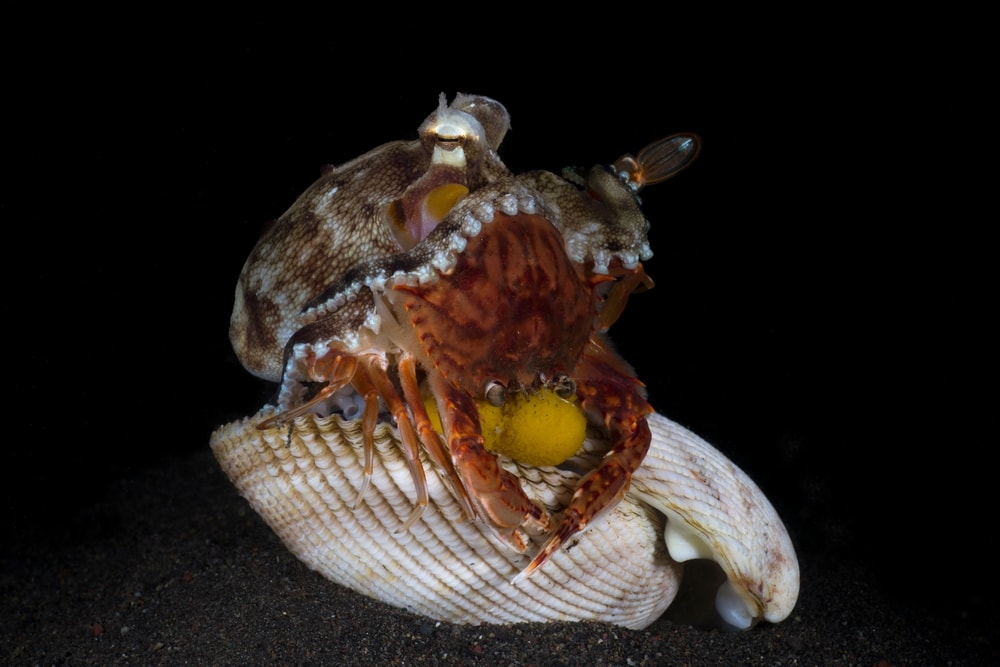
Coconut octopuses are carnivores that mostly eat crustaceans and mollusks. Some of their favorite foods include crabs, shrimp, and clams.
How Do Coconut Octopuses Eat?
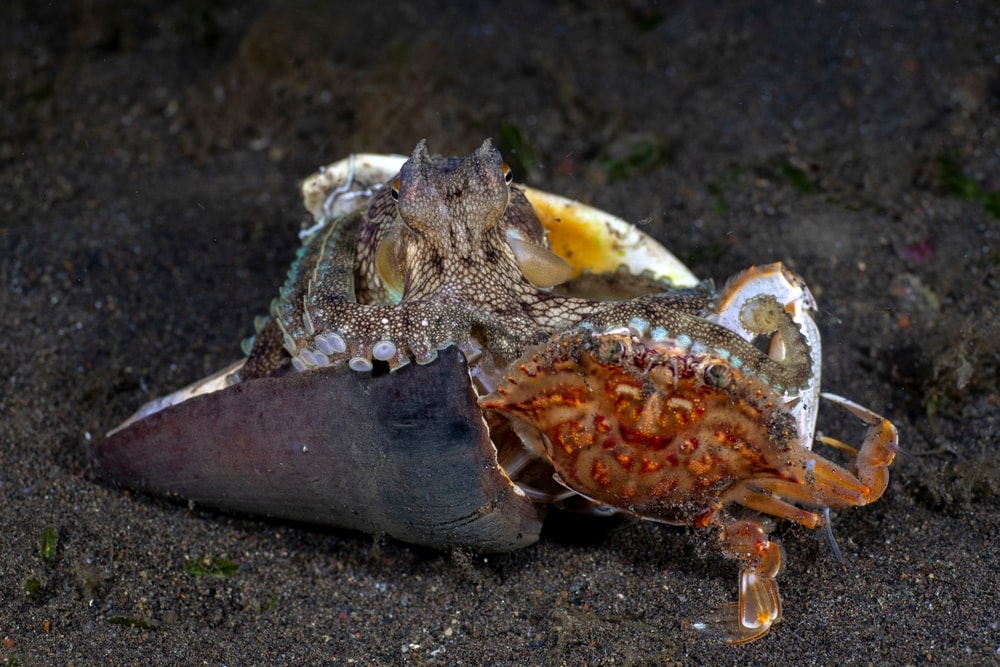
These cephalopods mostly hunt at sunrise and sunset. The light is still bright enough for them to see their prey but dim enough to hide them from predators.
To catch prey, they squeeze their flexible arms down holes in the mud or sand to find the smaller animals.
They will also cover themselves in mud or sand, only exposing their eyes. Unsuspecting prey swims or crawls past, and the octopus snatches it.
Waiting for their prey to move past them uses less energy than digging around in holes. It also keeps them safe from predators while they hunt.
Sometimes, prey wanders straight into the octopus’s coconut home. They don’t realize an octopus is living inside and walk right to their death.
Octopuses catch prey in their arms and move it toward their mouth on the underside of their mantle.
They have a sharp beak at the center of their body that they use to eat their prey. First, they pierce the shell of their prey, injecting it with a toxic venom that paralyzes them.
The octopuses’ digestive enzymes enter the prey and soften its body for digestion. They suck out the soft meat of the prey and leave the shell behind.
You may also like: A Deep Dive Into The Intriguing World Of 15 Different Types Of Jellyfish
Coconut Octopus Behavior & Communication
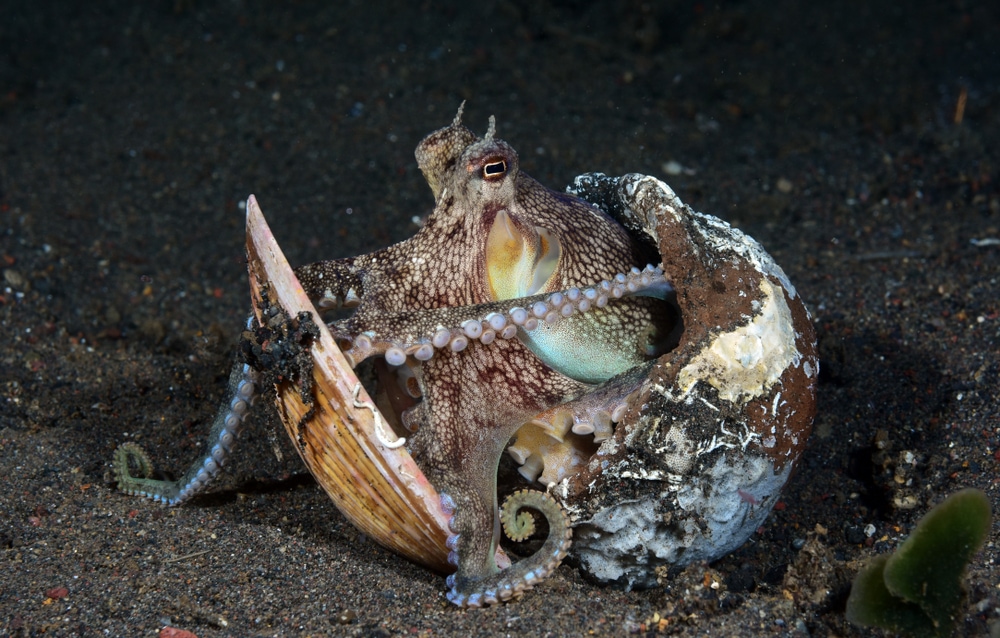
The coconut octopus gets its name because it has a habit of carrying around the halves of coconut shells. They use these shells as protection. They pull the shells over their bodies when feeling threatened. Besides coconuts, they also carry around seashells.
According to one study from 2009, the coconut octopus is the only invertebrate to use a tool for a function.
One researcher says “not even chimps have this sophistication to use an object to cover their heads.” Octopuses are one of the most intelligent animals in the world, and the coconut octopus proves it.
When they’re not covering themselves with the coconut shell, they carry it under their arm.
They walk using “bipedal locomotion.” This means they only use two of their arms to move across the substrate. The other six arms stayed curled against their bodies. Researchers fondly refer to this movement as “stilt walking.”
Check out the video below and see the coconut octopus carrying a coconut shell:
So far, we’ve only seen two other octopus species move this way.
Using only two arms to walk keeps their other six arms free for carrying coconut shells.
One study followed over 20 coconut octopuses. The study occurred off the coasts of northern Sulawesi and Bali. These octopuses carried stacks of coconut shells up to 65 ft (20 m) across the ocean floor.
Coconut octopuses can even travel while inside their coconut if they feel it’s unsafe to emerge.
Their gelatinous bodies lack an exoskeleton, which makes them incredibly flexible. They can roll around like a ball under the coconut to move. Predators don’t realize there is an octopus under the moving shell and move on.
Where Did They Pick Up This Behavior?
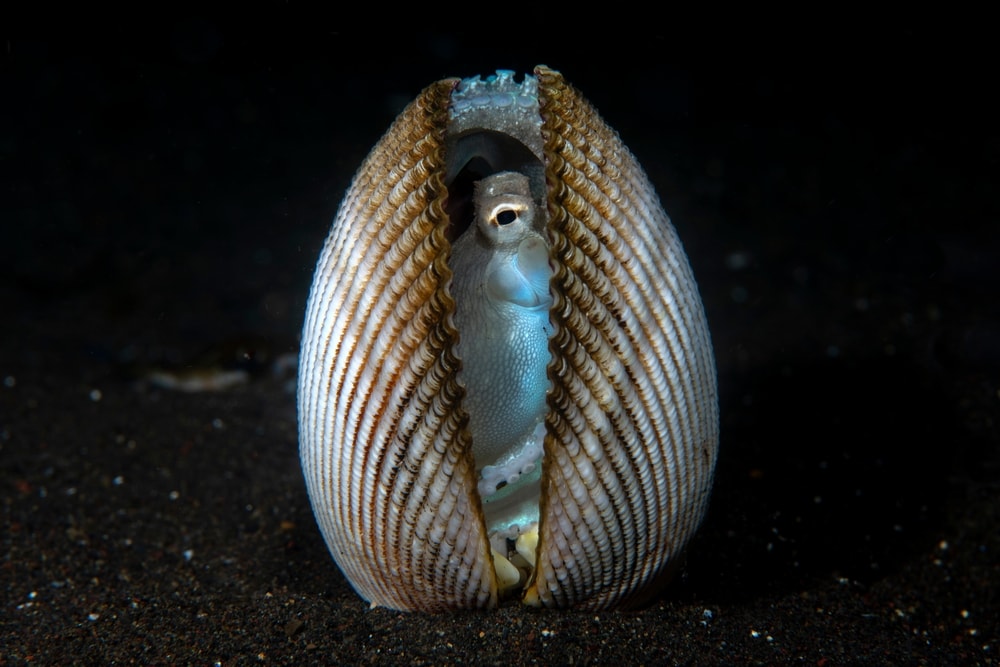
It’s not uncommon for octopuses to use discarded shells as places to hide from predators.
Coconut octopuses live in coastal waters near land. Many discarded coconut shells likely make their way into the water. These octopuses likely saw the large, hard shells as useful. So they began carrying them in place of shells.
Swimming Without A Coconut
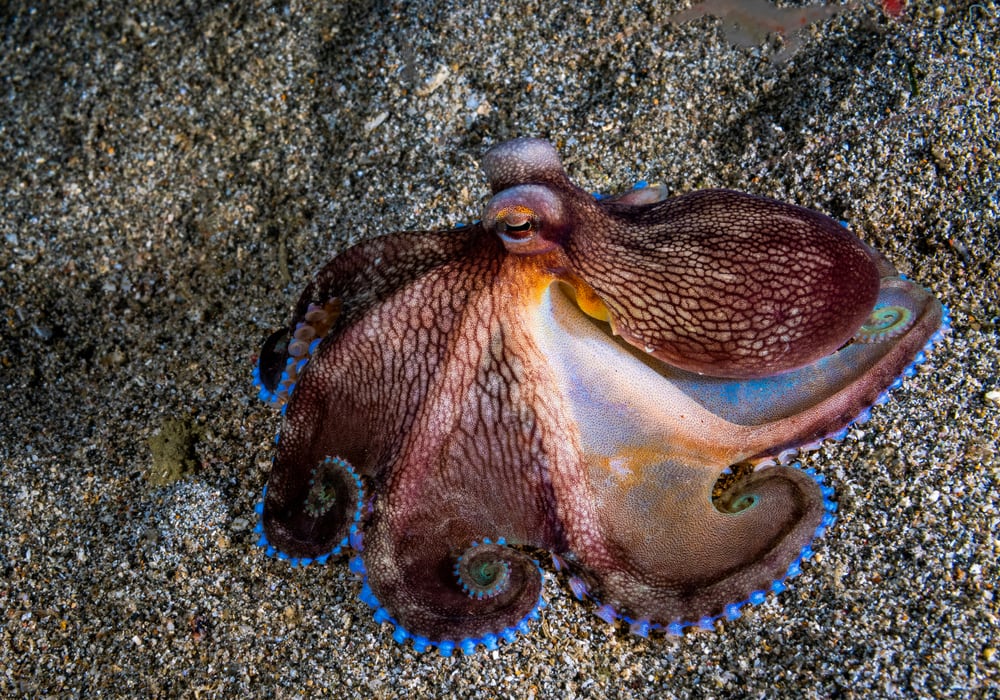
These octopuses can also use water-powered jet propulsion to move. Using water to propel themselves helps them move large distances quickly.
But they are bottom-dwelling animals. It’s more common for them to simply crawl across the seafloor with all eight arms.
Solitary Animals
Coconut octopuses are solitary animals that spend most of their lives alone.
You may also like: How Long Do Octopus Live? A Tragedy of Life and Death
How Do Coconut Octopuses Mate and Reproduce?
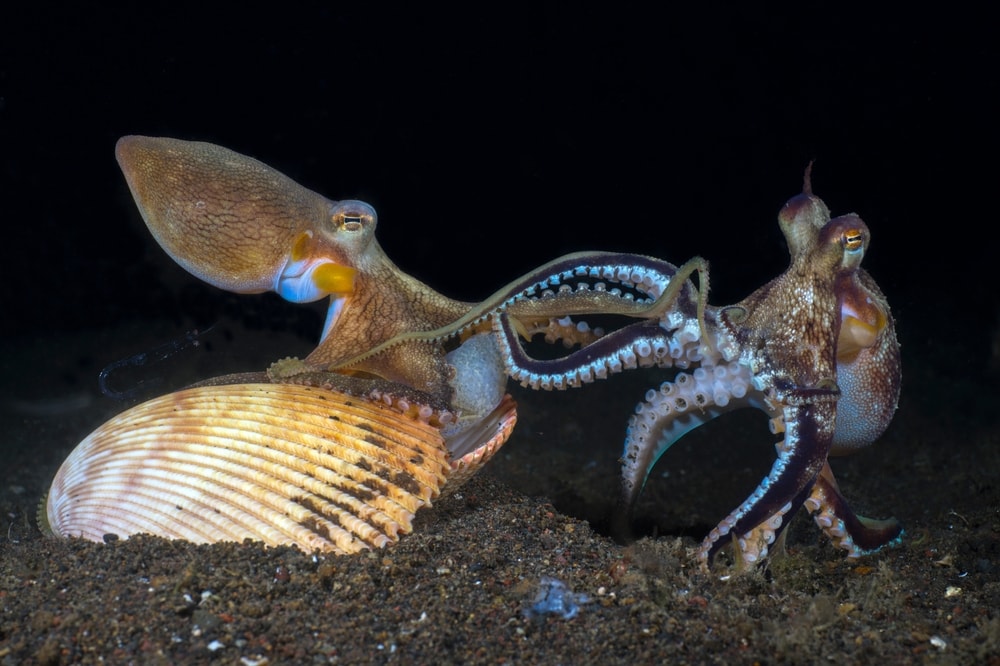
Coconut octopuses reach sexual maturity at around one to two years of age. Like all octopuses, their lives solely revolve around their young after mating. A mother forfeits her life for the care of her eggs and dies shortly after they hatch.
Octopus Reproduction
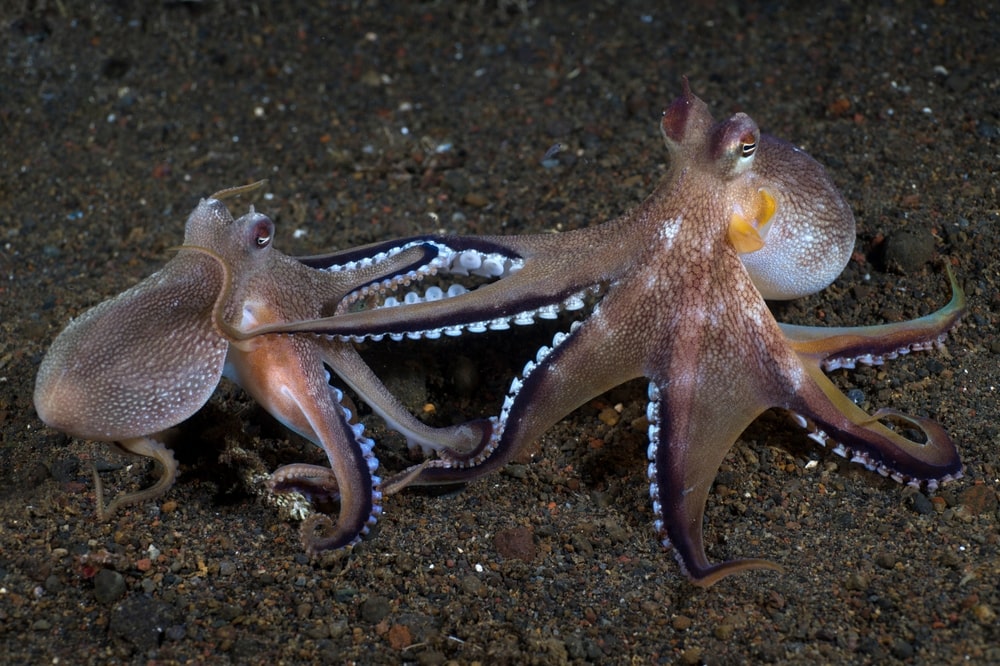
All octopuses mate in similar ways. As the oceans warm, males and females seek out partners to reproduce.
Males have a specialized arm, a “hectocotylus,” that they use to fertilize the eggs.
He holds a spermatophore, which is like a small package, with his hectocotylus. Then, he inserts his arm with the spermatophore into the female’s mantle cavity.
The incubation period is about 11 months, during which the eggs stay inside the mother. She lays up to 100,000 tiny eggs that are only about 0.24 in (6 mm) in diameter.
Mothers lay their eggs in a protected crevice where they can watch over them and care for them. One study shows that some birds attach their eggs to the inside of coconut shells. The coconut shell acts as protection for both the mother and her eggs.
Mother octopuses are fiercely protective of their eggs during the brooding period. They neglect their own health while the eggs develop and die shortly after they hatch.
After hatching, the planktonic baby octopuses are on their own. They drift through the water on the currents. They constantly search for food, like copepods.
Coconut Octopus Lifespan
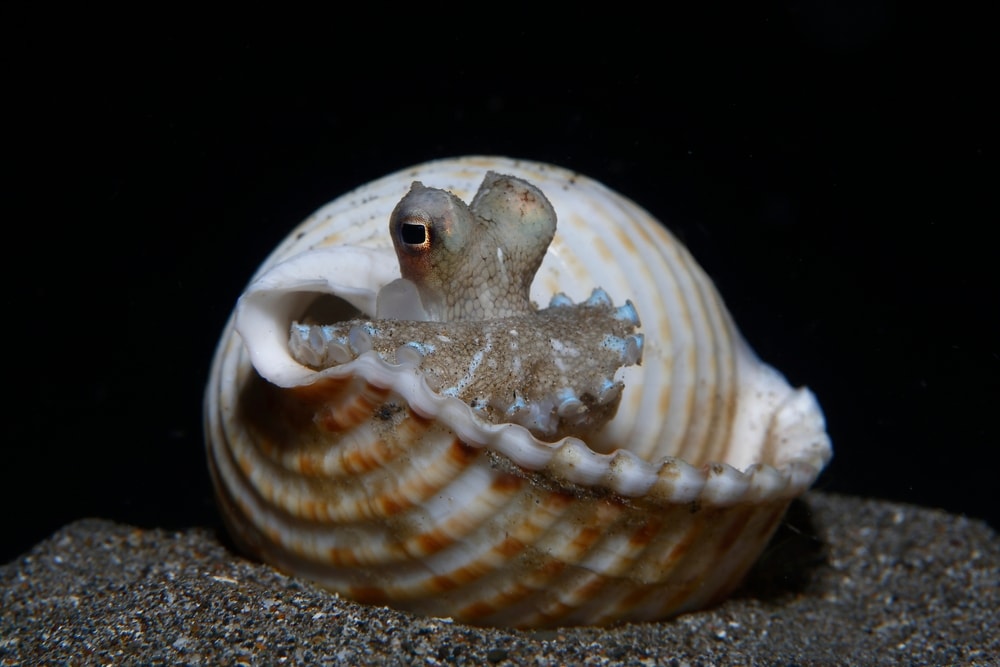
Despite being incredibly intelligent creatures, octopuses have short lifespans. Most octopus species live somewhere between six months and two years.
Coconut octopuses have a lifespan of three to five years, which is longer than most.
Coconut Octopus Populations & Conservation
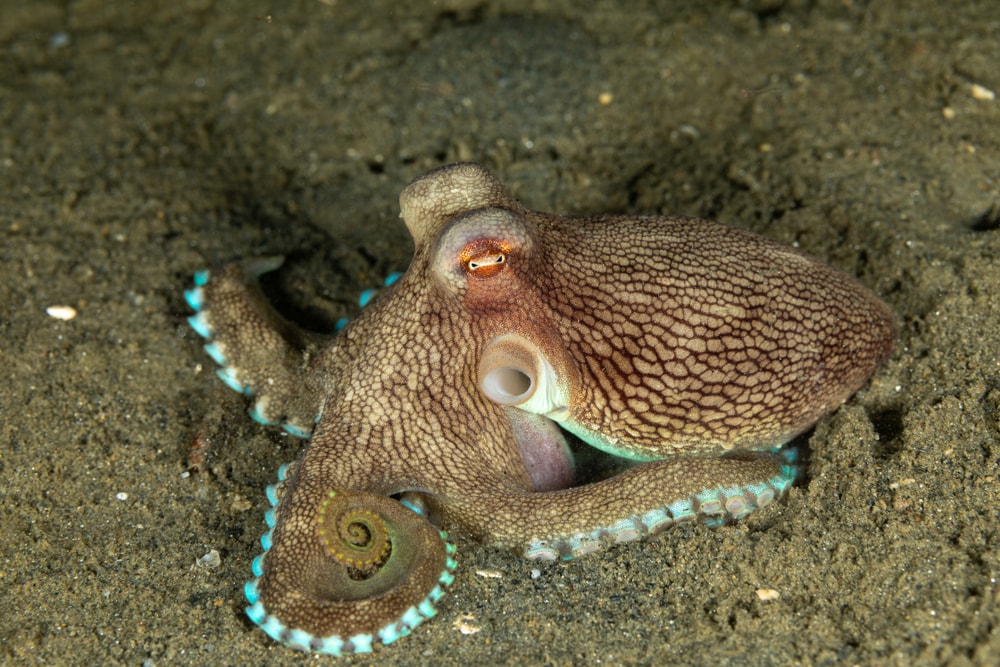
The International Union for the Conservation of Nature (IUCN) assessed the coconut octopus in 2018. They list them as “least concern” with an “unknown” population trend.
We know little about the conservation status of coconut octopuses. Still, they likely suffer from heavy fishing.
Do Coconut Octopuses Have Any Predators?
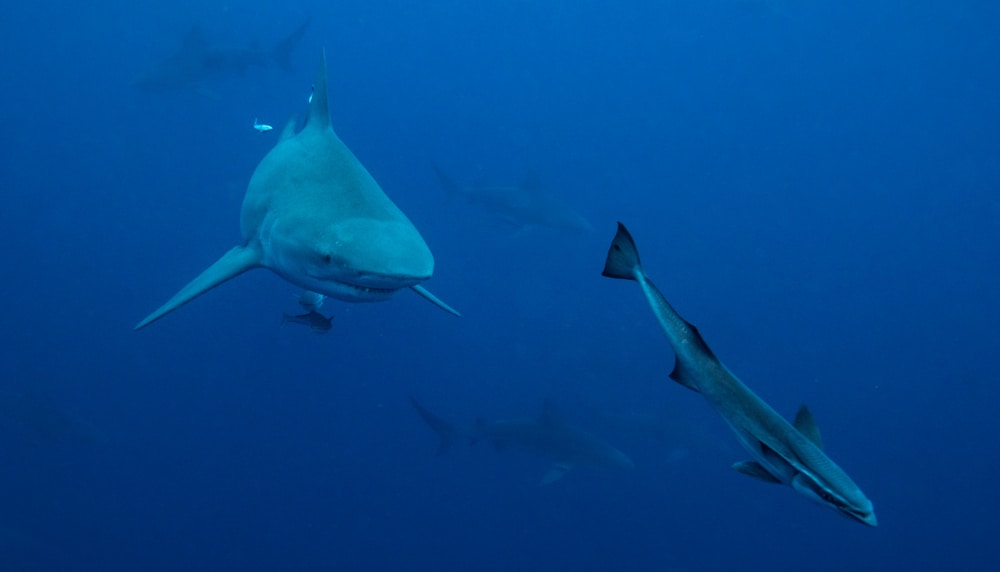
Coconut octopuses are so small and have a significant number of predators.
Great white sharks, bull sharks, eels, and viperfish are their primary predators. Even larger octopuses will target them when they have the chance.
When they feel threatened, octopuses release ink to blind and distract their opponent. The ink does not harm the predator; it merely gives the octopus time to escape.
Juvenile planktonic coconut octopuses are in greater danger from predation than adults. They are tiny creatures that float on the water’s currents. So, they often become part of the diet of plankton-eating whale species.
You may also like: A World Of Wonders: 14 Of Your Favorite Ocean Animals
FAQs
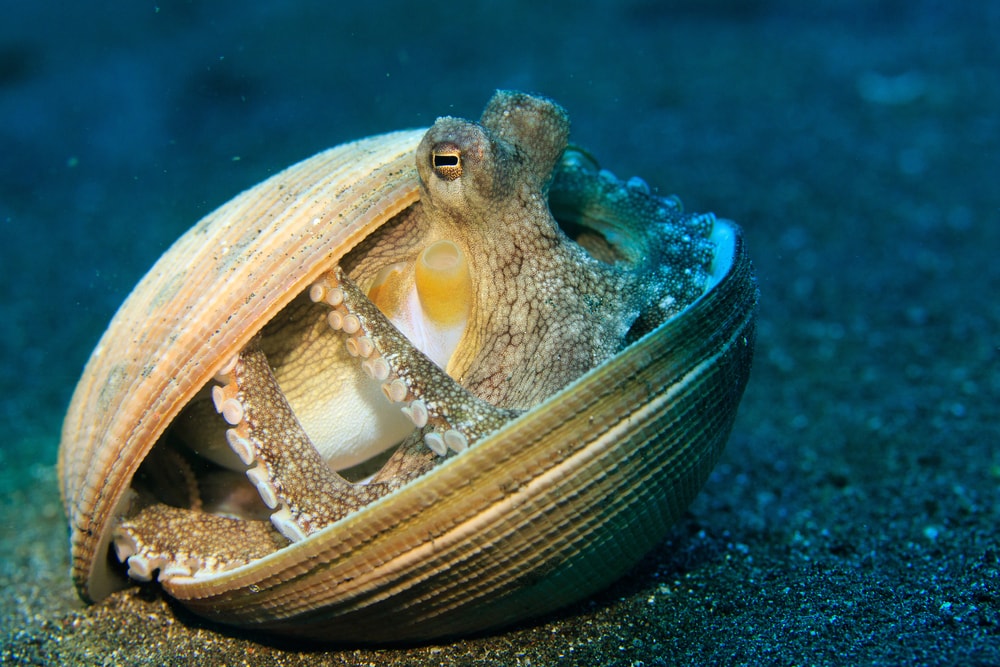
Are coconut octopuses venomous?
All octopuses are venomous, but only the blue-ringed octopus is dangerous to humans. The coconut octopus uses its venom to paralyze prey and make their bodies soft for eating.
How Does the Coconut Octopus Use Coconut Shells?
The coconut octopus is renowned for its remarkable ability to use coconut shells as tools for protection.
When threatened or in need of shelter, it quickly finds an empty coconut shell on the ocean floor and uses its muscular arms to maneuver inside, pulling the shell tightly against its body. It carries the shell around with it, providing a safe hiding place wherever it goes.
What Makes the Coconut Octopus Stand Out Among Other Octopus Species?
The coconut octopus stands out due to its exceptional problem-solving abilities and tool usage. It is one of the few known invertebrates capable of using objects in its environment for protection.
More from Outforia
Check out these other amazing cool and awesome octopus species!



